MakerDAO CDP Tutorial – How To Take Out a Loan on the Blockchain
This post will teach you the concept behind MakerDAO, LIDO, and how to form a Collateralized Debt Position (CDP) to take out a loan on the blockchain with a positive interest rate.
After reading this article I hope you’ll understand the macro picture of how this Defi play works to give you a beneficial loan. You’ll also indirectly learn about some major players in the web 3.0/blockchain/defi space.
As always, none of this is investment/tax/legal advice. It’s just my own explorations, presented as informative entertainment. Anything on the blockchain is risky.
However, I am highlighting this defi position because it utilizes some of the largest and oldest blockchain protocols.
I like to think of it as a good play to earn on your money in a relatively safe way.
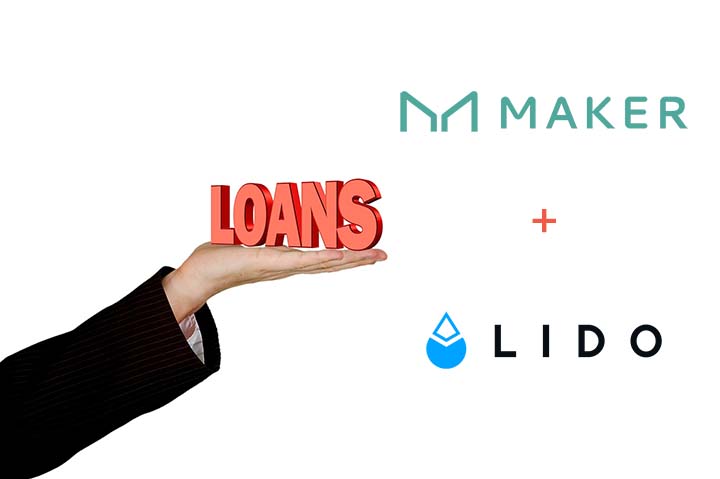
Why Take Out a Loan with MakerDAO CDP and Wrapped Staked ETH?
This idea of this post was to answer a question I had for myself – “ok, how can you still earn some money and get somer liquidity in a (relatively) safe way while protecting a bulk of your investment?”
This MakerDAO CDP is not about throwing your savings into a crazy layer 2 moonshot, or earning 1000% APY.
It is a way to hold an ETH position, earn some interest AND get some stable coins that you can either cash out to fund your real life or use those stable coins for further speculation/interest gains.
That said, Ethereum is an extremely volatile asset. Also, we’ll be interacting with 2 smart contracts one on Lido, and then one with MakerDAO.
Doing anything with your ETH other than holding it in cold storage adds additional risk. BUT as you’ll learn in this article both Lido and MakerDAO are pretty established stable players in the market.
A Quick Run Down of the MakerDAO Lido Strategy
We’ll convert our ETH into Wrapped StakedETH using Lido. This earns us 4.4% interest on our ETH holdings in ETH. You could stop there.
But, what if we also want/need some money to fund everyday life. So we’ll then take out a loan against that wrapped staked ETH in DAI for 2.5%. You can then take that DAI, convert it to USDC, cash it out through Coinbase and put it in your bank.
This loan prevents you from having to sell your ETH position and maintains your exposure to the (hopefully) upward price movement of ETH. All while you’re earning more on ETH in interest than you’re paying in fees on DAI.
If that made sense, you can create a CDP and receive 5% off fees here.
(Note: Maker implemented a fee discount and referral program AFTER I created this article. I will receive a small cut, from Maker not you, if you use my link. You’ll also receive a 5% discount that you wouldn’t otherwise. That said, do what you want. This article is for informational purposes. Using my link helps me create more informative content, but up to you!)
For those of you who want a little more, let’s break all that^^^ down into parts.
What is MakerDAO?
MakerDAO is an established DeFi player in the Ethereum space that enables borrowing on the Blockchain through Collateralized Debt Positions (CDPs). When a user opens a CDP they can borrow Maker’s decentralized stable coin, DAI.
At the time of this writing, Maker has over $15 Billion in Total Value Locked making it the second biggest Defi Protocol behind Cruve finance.
DAI has a circulating supply of $9 billion – making the stablecoin one of the largest and highly liquid stable coins.
Going into the details of how MakerDAO CDPs create DAI and maintain its peg to $1 is a bit long for this article, but the protocol has been around for a while. In fact, MakerDAO “invented Defi” with it’s CDP. Below is a video I made in 2018 about my experience taking out a CDP in the early days.
This video covers a lot of the basics around Maker/DAI, stablecoins and CDPs. Also, spoiler alert – I actually got liquidated… but I and the blockchain have matured since then. Here’s to better luck in round 2 ????
What is Lido?
Lido is a decentralized staking as a service provider. It enables users to contribute to Proof of Stake protocols without having to run a node and receiving the benefits of liquid staking.
We’ll look at how this works on Ethereum.
Ethereum is switching from Proof-of-work to Proof-of-stake. At a super simplified level, that means in order to secure the Ethereum blockchain and mine Ethereum, users have to stake ETH as collateral to run a node rather than dedicate computing power to “work” through complex computing problems. This (should be) a good thing for scalability, speed and the environment.
The hard part though, is to run a proof of stake Ethereum node you need:
- Technical knowledge so that you set it up correctly and comply /stay on top of updates so you don’t get penalized and your stake gets slashed
- To have 32 ETH that you stake inside your node.
So while running a node can be profitable, a lot of people don’t want to deal with the technical overhead and risk of doing so. Many also don’t have 32 ETH to lock into a node. That’s a lot of money.
So Lido created a DAO that has verified staking as a service providers who can stake users ETH in a non custodial manner. Lido users still maintain control of their private keys and their ETH is in the hands of a smart contract as opposed to a centralized entity.
This allows users to deposit a smaller amount of ETH and let professionals run a node on everyone’s behalf. The professionals simply take a cut of the interest that is earned.
What is stETH?
On top of lowering the barrier to entry from a technical and monetary standpoint Lido also enables something called liquid staking.
When you stake your ETH with Lido you get a token called Staked ETH (stETH) in return. This token is 1:1 with ETH. You can trade it back into the Lido interface or you can swap it on decentralized exchanges like Uniswap etc. This gives users more freedom than locking their own 32 ETH into their own node, leaving them unable to do anything else but earn interest.
While Lido is somewhat new, it has a lot of clout. Recently, a16z, one of the leading investment firms invested $70 Million into the DAO. Also, Lido is staking over $12.5 billion in assets and holds over a 20% share of all staked ETH and even more of the liquid staking market.

What is Wrapped Staked ETH? (wstETH)
Wrapped Staked ETH (wstETH) is a wrapped version of Lido’s stETH. wstETH is also created by Lido and earns the same interest as stETH, only the interest accumulates in a way that makes the token more compatible with other Defi protocols. At the time of this writing, both wstETh and stETH are earning 4.4% APR.
stETH is a rebasing token. That means that the number of tokens in your wallet changes to reflect interest, so if you turn 100eth into 100 stETH, after 1 year you should have 104.4 stETH which you can turn back into 104.4 ETH. That works just fine from a human user perspective, but the changing balance doesn’t play well from a technical/codebase perspective with other defi protocols.
To make stETH more operable with other defi platforms they formed wrapped staked eth. This wstETH works by changing the underlying exchange rate. So wstETH won’t be 1:1 with ETH.
Instead, the exchange rate will work in the favor of wstETH over time. So on day 1 when wstETH launched it was 1:1 with ETH and stETH. But after 1 year. The exchange rate would be more like 1:1.044.
Meaning when you got out of wstETH you could cash each wstETH in for 1.044 ETH – earning you that same 4.4% APR.
Again, the only reason for this is so that the token fits in better with other defi protocols that haven’t built compatibility for the idea of a changing quantity in their locked assets.
Side Note:
If you want to learn more about rebasing tokens. My team and I work with Ampleforth, one of the pioneers in rebasing tokens. Here’s a video that we made to help Ampleforth explain how they use the rebasing concept. It’s semi-irrelevant to this article but I wanted to show off our professional video work. Hit us up if you need a video! hi@Peerthrough.com
How To Get Wrapped Staked ETH
You can wrap your staked ETH or your ETH directly on the Lido site here: https://stake.lido.fi/wrap
Simply connect your wallet with either ETH or stETH and wrap it up with one click and a gas fee.
Note: it’s worth checking uniswap to see if you’ll get a better rate swapping to wstETH from ETH than you would generating it on the lido site. BUT, wstETH isn’t traded as much on DEXs so personally I got better rates just wrapping through Lido.
wsETH + MakerDAO CDP
MakerDAO accepts wrapped staked ETH as collateral to take out a loan. That means that you can convert your eth to wstETH to earn 4.4% and then borrow DAI against that ETH.
The wstETH remains in the vault, accruing interest toward your principal, all of which you get once you pay back the loan. Right now the interest rate on a DAI loan from the wstETH vault is 2.5%. So if the price of ETH were to stay even and DAI remains at $1 dollar, which it is meant to do – you are earning 1.9% while borrowing money. (4.4-2.5%).
Take 5% off your fees through this Maker DAO CDP promo code
wsETH + MakerDAO CDP Risks
While the deal is great, there are of course risks. Those risks are:
Smart contract risk of both Lido and Maker
As mentioned the safest place for your ETH is cold storage. Don’t interact from that wallet until you want to sell.
To open a wstETH CDP you have to give your ETH to Lido’s smart contract to create wstETH in order to earn the 4.4%. Then you have to give that wsETH to MakerDAO on the Oasis Dapp to form a CDP.
While these are all transparent smart contracts, meaning you don’t have to worry about the company running away with your money as you still have your private keys, there is still a risk of one of the contracts being hacked and draining everyone’s money.
I like to hope/think this risk is relatively small given the size, age and prominence of these two protocols – they are #2 and #3 in web3 interms of TVL – but, it is the blockchain world. A 15 billion hack is always possible 🙂
Price Volatility of Collateral (wstETH)
As we’ve learned a Collateralized Debt Position requires you to deposit collateral in order to take out debt (DAI). Each CDP has a minimum collateral ratio. In the case of a wstETH CDP, the collateral ratio can’t fall below 160%. That minimum threshold can be breached if the price of your underlying collateral drops.
If it does, you get liquidated at a 13% fee. Meaning the assets in your CDP are automatically sold off to pay back your debt + 13% more.
So if liquidated you wouldn’t lose all your wstETH, but you would be forced to sell it to pay back the DAI + sell 13% extra.
(That 13% extra is a proceed that goes to burning MKR token, thus benefiting MKR holders).
For this reason it is very important to know the liquidation price of your underlying asset. ex: I know if ETH drops below $1000, my CDP is liquidated. So if, god forbid, ETH approaches those levels, I either need to add more collateral or pay back some of the debt to steer clear of liquidation.
Ability to pay back your debt
In order to unlock your underlying collateral, you have to pay back the DAI you borrowed from MakerDAO. So if you take out the loan and spend it or lose it speculating on another risky protocol – your collateral is kind of locked in there.
Now you can get out of it by selling your CDP or slowly backing out of your position.
BUT the fact remains, you won’t have true access to your underlying collateral until you pay back your debt in full.
In the case of wstETH, if price of ETH remains constant (or goes up) the interest on your collateral should be growing faster than the interest on your debt, so theoretically this loan would kinda pay itself back eventually. But you’ll still have to make moves to unlock everything.
MakerDAO CDP Tutorial
Now that you understand the big picture, the actual button clicking process of opening up a CDP is quite simple. MakerDAO has done a great job with their UI. Much better than when it first came out.
Opening a CDP is done through your wallet, likely metamask, and the Oasis DApp: https://oasis.app/borrow
You’ll see there are quite a few assets you can use as collateral, all with different parameters. I chose the wstETH because I wanted to earn yield on my ETH and maintain exposure to the upward price movement – all while borrowing against it.
Using Oasis.App
Oasis is the user interface/dapp owned by maker that allows you to open a CDP. It’s quite intuitive and does most of the calculations for you. It might still be useful for you to work out some ideas on a spread sheet, but given how good the interface is – up to you. Let’s take a look at a hypothetical example where we lock up 100 wstETH and take out a loan of $75,000 DAI
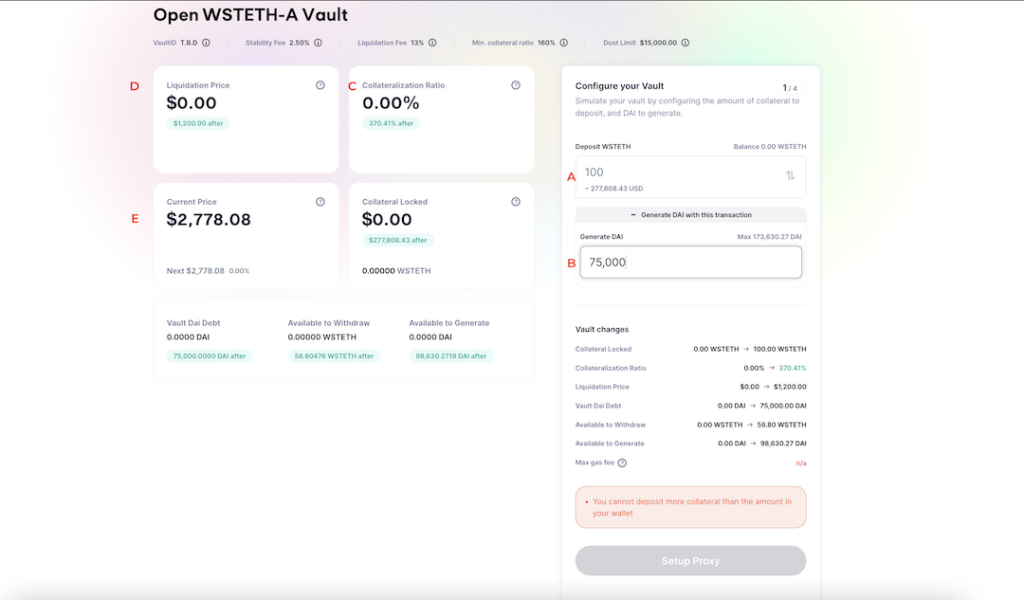
As you can see, everything is pretty straight forward. Once you go to oasis.app and the borrow tab, you connect your wallet and pick your collateral type. Then you’ll see the screen above.
(Be sure you’re on the borrow, not multiply tab. Multiply loops your deposit / loan to create leverage. Not the same thing. Too much for this post.)
Looking at the screenshot – I didn’t actually open this position, the the main numbers are 0’s in black, but the highlighted green saying “after” is showing me what my position would be “after” I locked my collateral and generated some DAI. So let’s take a look.
Breaking Down the Oasis CDP UI from MakerDAO
In the photo:

Very top row – shows your vault ID (created once you open the vault), stability fee (interest rate on loan), liquidation fee (penalty if liquidated), min. collateral ratio (don’t fall below this), and dust limit (minimum loan you can take out. I guess this is to prevent people from taking out small loans and overloading the protocol? Not sure honestly – but fair enough).
A – shows the amount of wrapped staked ETH I (hypothetically) chose to deposit. 100, and it’s underlying dollar value 277,808.43
B – Shows the loan size I (hypothetically) chose to take out. 75000. In the top right corner of B, it will show the max amount I could possibly take out. NEVER take out the max though, because if the price of your underlying collateral drops even 1 penny – you’ll be liquidated and incur a 13% fee.
C – Shows your current collateralization ratio. In this case, 370.41% = (277,808.43/75000). This ratio needs to stay above the minimum for the vault.
D – Liquidation price – If the price of your collateral asset falls below this, you will be liquidated. In our case $1,200. Liquidation price is perhaps the most important metric to keep in mind. Set an alert to be sent to you well above that price so that you have time to pay back some loan or add more collateral and save liquidation. In this case, I’d personally take action at 1600 to give even more padding.
Ok the rest of the information on the screen is redundant or just about gas fees or something. That said, creating wstETH and opening a CDP is gas intensive so probably best to do it when network usage/gas is low.
Additional Steps
Proxy
If it’s your first time opening up a CDP. You’re going to create a Proxy. This proxy is a smart contract wallet (which you still own) that enables the Oasis Dapp to make multiple interactions in one transaction.
Creating a proxy is a bit gas intensive but it’s a 1 time fee per address. Kind of like when you initiate your wallet on opensea.
Allowance
You also have to approve the underlying collateral for spending. Similar to how you have to do this on a DEX. What’s cool is the Oasis Dapp lets you pick an allowance. You can choose unlimited, the amount you want to spend in that moment, or set an amount if you think you’ll be interacting just a bit more in the future. This approval isn’t too bad when it comes to gas.
All and all I spent just under $200 in gas fees swapping from ETH to wstETH, setting up a proxy, approving and opening a CDP. Not bad 🙂
What To Do With Your DAI?
Your DAI is now money. You have a loan. What you do is up to you. I needed some liquidity to continue to run this blog, so I took the DAI, converted it to USDC – sent the USDC to coinbase and cashed it into my fiat bank account.
That’s great and what I needed. However, I will have to pay back the loan.
Other options are to take the DAI and buy more ETH, or risk it on meme coins and NFTs, or perhaps you just put the DAI in a stablecoin vault where you can likely learn 15-20% interest. Meaning you’re outpacing the cost of borrowing, so you can then take it out and pay back your loan even easier.
Really, it’s your money and as we know with the blockchain – the possibilities are endless. So do what you want but use it wisely. Perhaps apply some of these wealth creation principals. Be safe. Have Fun.
MakerDAO CDP Loan Conclusion
MakerDAO is one of the oldest, largest and most trusted Defi protocols. Now, with the addition of Lido’s wrapped staked ETH as collateral, users can take out net positive loans.
I hope this article taught you how to open a MakerDAO CDP, the broad principals behind it and gave you a good understanding of some of the larger players in the Defi industry.
If you do decide to open up a Maker DAO CDP, here is a referral code that gives you 5% off any fees associated with the process.
Thanks for reading!


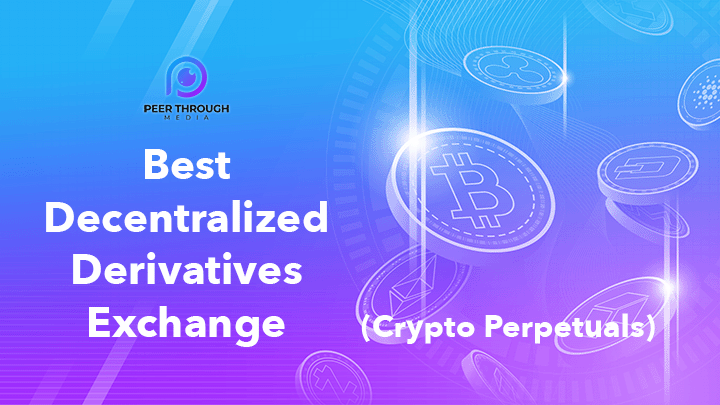
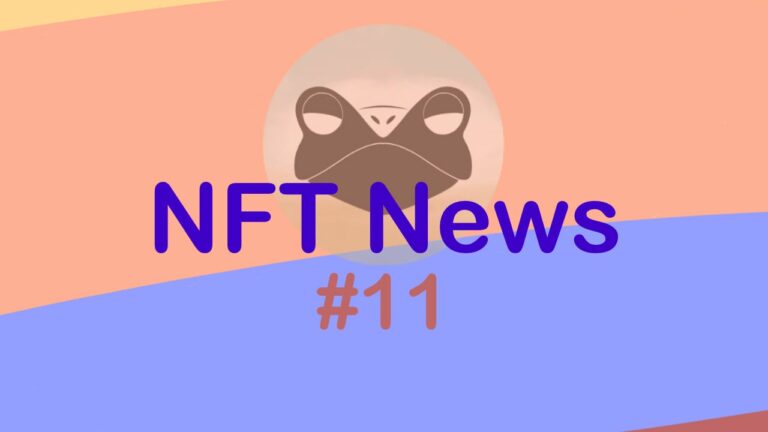

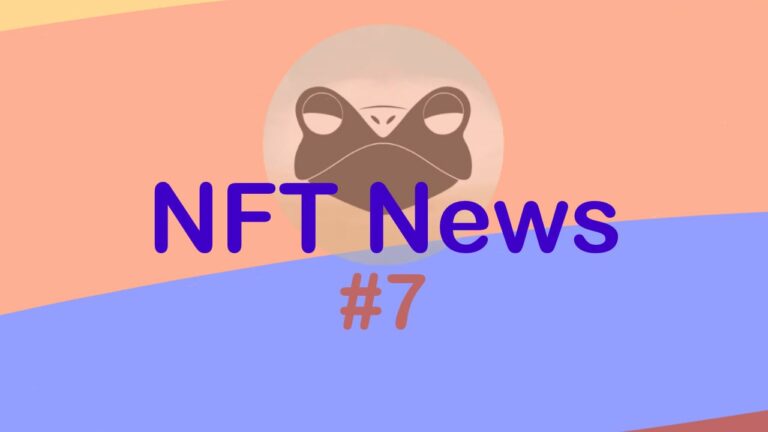
![What Is The Safest Way To Store Crypto? [2023]](https://www.peerthroughmedia.com/wp-content/uploads/2023/01/SAFEST-WAY-TO-STORE-CRYPTO-768x432.jpg)